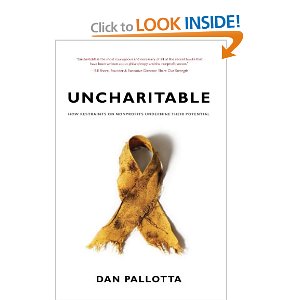 If you are collecting data on your non-profit organization’s performance and doing nothing with it, then you should be tarred and feathered. You are too busy to be doing things that don’t get you a return on investment on your time. Unfortunately, data collection can be time-consuming if you haven’t built good systems to make collection easy, and there are too many small non-profit organizations who are under-resourced and haven’t built those systems.
If you are collecting data on your non-profit organization’s performance and doing nothing with it, then you should be tarred and feathered. You are too busy to be doing things that don’t get you a return on investment on your time. Unfortunately, data collection can be time-consuming if you haven’t built good systems to make collection easy, and there are too many small non-profit organizations who are under-resourced and haven’t built those systems.
So, why do so many agencies still invest the time to collect data when it is difficult to do and so incredibly time-consuming? In almost every instance that I’ve seen, it is simply because a donor is requiring it or they are affiliated with a national organization that makes it mandatory.
Here is a thought . . . if you are going through the effort, then why not benefit from it?
What should you measure?
The “WHAT” is hard to answer unless you know the “WHY”. In other words, you should measure things relating to board engagement and performance if you want to improve those things. You should measure things relating to money and donor behavior if you want to improve your resource development.
One national organization with whom I am very familiar (wink, wink), developed an entire organizational scorecard full of key performance indicators (KPIs) that breakdown into the following five ares:
- strategic growth
- increased impact
- financial health
- resource development
- board of directors
 I know that a number of subscribers to this blog aren’t members of this “unnamed national organization,” and you are probably wondering what are some of the KPIs listed under these categories. While I don’t think I’d be violating any major trade secrets in sharing those KPIs with you, I want to be respectful of their work. So, I’ll only share a few of those KPIs to give you an idea and a start:
I know that a number of subscribers to this blog aren’t members of this “unnamed national organization,” and you are probably wondering what are some of the KPIs listed under these categories. While I don’t think I’d be violating any major trade secrets in sharing those KPIs with you, I want to be respectful of their work. So, I’ll only share a few of those KPIs to give you an idea and a start:
- net change in number of clients service
- average days cash on hand
- net change in total income
- percent of board volunteers that attended 75% of meetings
- percent of board volunteers who make a personal unrestricted financial gift
- percent of board volunteers who make a face-to-face solicitation on behalf of the agency
If you are interested in developing KPIs and a scorecard for your non-profit organization, here are a few resources I’ve found online that may help you:
- Association of Fundraising Professionals: “Key Performance Indicators: Nonprofits Need Them, Too!“
- Liz Marenakos of Blackbaud: “Identifying and Measuring KPI’s“
- Virtue Center: “Brutal Honesty: Measuring Non-Profit Success with Key Performance Indicators“
What next?
 I point you back to my inflammatory opening sentence:
I point you back to my inflammatory opening sentence:
“If you are collecting data on your non-profit organization’s performance and doing nothing with it, then you should be tarred and feathered.”
Collecting this data isn’t rocket science, but it is time-consuming and you’re too busy to invest that time and get nothing back in return. Right?
If you are measuring program-related KPIs (e.g. outcomes data, impact data, etc), then you should share that info with the staff responsible for those programs. If you are measuring fundraising-related KPIs, then you should share that info with your fundraising staff and fundraising volunteers. If you are measuring board engagement related KPIs, then you should share that info with board volunteers.
I believe all KPIs should be shared with all board members in all instances (but at the appropriate time and setting) so they understand whether or not the organization is healthy or unhealthy. I also believe that where possibly, KPIs should be directly tied to performance management systems and evaluation tools.
The big idea here is that collecting this type of data, sharing this type of data, and integrating this type of data into systems like employee performance appraisal and board evaluation will drive change because it creates urgency, accountability and the assessment information necessary upon which organizational plans can be built.
Has your agency developed KPIs? If so, how do you use them? With whom do you share your data? What has been the result? Please use the comment box below to share your experiences.
Here’s to your health!
Erik Anderson
Founder & President, The Healthy Non-Profit LLC
www.thehealthynonprofit.com
erik@thehealthynonprofit.com
http://twitter.com/#!/eanderson847
http://www.facebook.com/eanderson847
http://www.linkedin.com/in/erikanderson847







 Identifying blog topics can be hard. Sometimes you find a comfort zone and ideas flow freely. Other times, it is next to impossible and the writers block is crippling. So, I love it when readers sometimes email me on the side and suggest topics.
Identifying blog topics can be hard. Sometimes you find a comfort zone and ideas flow freely. Other times, it is next to impossible and the writers block is crippling. So, I love it when readers sometimes email me on the side and suggest topics.


























